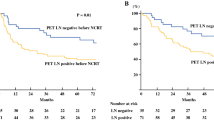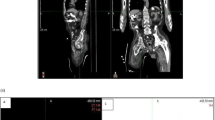Abstract
Purpose
The aim of this study was to determine the benefits of 18F-fluorodeoxyglucose positron emission tomography (PET)/computed tomography (CT) compared to CT alone in the preoperative assessment of lymph node metastasis in patients with esophageal cancer.
Methods
One-hundred and seven patients who underwent esophagectomy with lymph node dissection between March 2007 and December 2009 were eligible. Sixty-seven patients were treated with surgery alone (SA group), while 40 patients received preoperative treatment prior to surgery (PT group). The pathological results of 1,403 dissected lymph node stations were compared with the results obtained using each imaging modality.
Results
PET/CT showed a significantly higher specificity and positive predictive value (PPV) than CT alone (97.7 vs. 94.1 % and 64.6 vs. 44.0 %, respectively), when analyzed by the lymph node stations. The PPV of PET/CT for N1 cases was significantly better than that of CT alone (78.9 vs. 53.9 %), particularly in the PT group (91.3 vs. 65.4 %). Among the patients in the SA group, the number of metastatic nodes was significantly higher in PET-N1 cases than in PET-N0 cases (5.78 vs. 1.90).
Conclusion
PET/CT is useful for selecting patients with multiple lymph node metastases and also for detecting residual metastatic nodes after PT, and thus is beneficial to decide on the appropriate treatment strategy for patients with esophageal cancer.


Similar content being viewed by others
References
Eloubeidi MA, Desmond R, Arguedas MR, Reed CE, Wilcox CM. Prognostic factors for the survival of patients with esophageal carcinoma in the US: the importance of tumor length and lymph node status. Cancer. 2002;95:1434–43.
Mariette C, Piessen G, Briez N, Triboulet JP. The number of metastatic lymph nodes and the ratio between metastatic and examined lymph nodes are independent prognostic factors in esophageal cancer regardless of neoadjuvant chemoradiation or lymphadenectomy extent. Ann Surg. 2008;247:365–71.
Roder JD, Busch R, Stein HJ, Fink U, Siewert JR. Ratio of invaded to removed lymph nodes as a predictor of survival in squamous cell carcinoma of the oesophagus. Br J Surg. 1994;81:410–3.
Tachimori Y, Ozawa S, Fujishiro M, Matsubara H, Numasaki H, Oyama T, et al. Comprehensive registry of esophageal cancer in Japan, 2006. Esophagus. 2014;11:21–47.
Ando N, Iizuka T, Ide H, Ishida K, Shinoda M, Nishimaki T, et al. Surgery plus chemotherapy compared with surgery alone for localized squamous cell carcinoma of the thoracic esophagus: a Japan Clinical Oncology Group study-JCOG9204. J Clin Oncol. 2003;21:4592–6.
Igaki H, Ando N, Shinoda M, Shimizu H, Nakamura T, Ozawa S, et al. A randomized trial of postoperative adjuvant chemotherapy with cisplatin and 5-fluorouracil versus neoadjuvant chemotherapy for clinical stage II/III squamous cell carcinoma of the thoracic esophagus (JCOG 9907). 2008 ASCO Annual Meeting Boston, 2008.
Ando N, Kato H, Shinoda M, Ozawa S, Shimizu H, Nakamura T, et al. A randomized trial comparing postoperative adjuvant chemotherapy with cisplatin and 5-fluorouracil versus preoperative chemotherapy for localized advanced squamous cell carcinoma of the thoracic esophagus (JCOG9907). Ann Surg Oncol. 2012;19:68–74.
Sugimachi K, Ikebe M, Kitamura K, Toh Y, Matsuda H, Kuwano H. Long-term results of esophagectomy for early esophageal carcinoma. Hepatogastroenterology. 1993;40:203–6.
Yoon YC, Lee KS, Shim YM, Kim BT, Kim K, Kim TS. Metastasis to regional lymph nodes in patients with esophageal squamous cell carcinoma: CT versus FDG PET for presurgical detection prospective study. Radiology. 2003;227:764–70.
Kneist W, Schreckenberger M, Bartenstein P, Grunwald F, Oberholzer K, Junginger T. Positron emission tomography for staging esophageal cancer: does it lead to a different therapeutic approach? World J Surg. 2003;27:1105–12.
Kim K, Park SJ, Kim BT, Lee KS, Shim YM. Evaluation of lymph node metastases in squamous cell carcinoma of the esophagus with positron emission tomography. Ann Thorac Surg. 2001;71:290–4.
Kato H, Miyazaki T, Nakajima M, Takita J, Kimura H, Faried A, et al. The incremental effect of positron emission tomography on diagnostic accuracy in the initial staging of esophageal carcinoma. Cancer. 2005;103:148–56.
Kato H, Kuwano H, Nakajima M, Miyazaki T, Yoshikawa M, Ojima H, et al. Comparison between positron emission tomography and computed tomography in the use of the assessment of esophageal carcinoma. Cancer. 2002;94:921–8.
Yamada H, Hosokawa M, Itoh K, Takenouchi T, Kinoshita Y, Kikkawa T, et al. Diagnostic value of 18F-FDG PET/CT for lymph node metastasis of esophageal squamous cell carcinoma. Surg Today 2013. (Epub ahead of print, PMID 24077997).
Beck JR. Likelihood ratios. Another enhancement of sensitivity and specificity. Arch Pathol Lab Med. 1986;110:685–6.
Dwyer AJ. Matchmaking and McNemar in the comparison of diagnostic modalities. Radiology. 1991;178:328–30.
Sjoquist KM, Burmeister BH, Smithers BM, Simes R, Zalcberg JR, Barbour A, et al. Survival after neoadjuvant chemotherapy or chemoradiotherapy for resectable oesophageal carcinoma: an updated meta-analysis. Lancet Oncol. 2011;12:681–92.
Funai T, Osugi H, Higashino M, Kinoshita H. Estimation of lymph node metastasis by size in patients with intrathoracic oesophageal cancer. Br J Surg. 2000;87:1234–9.
Tohnosu N, Onoda S, Isono K. Ultrasonographic evaluation of cervical lymph node metastases in esophageal cancer with special reference to the relationship between the short to long axis ratio (S/L) and the cancer content. J Clin Ultrasound. 1989;17:101–6.
Kato H, Kimura H, Nakajima M, Sakai M, Sano A, Tanaka N, et al. The additional value of integrated PET/CT over PET in initial lymph node staging of esophageal cancer. Oncol Rep. 2008;20:857–62.
Beyer T, Townsend DW, Brun T, Kinahan PE, Charron M, Roddy R, et al. A combined PET/CT scanner for clinical oncology. J Nucl Med. 2000;41:1369–79.
Poeppel TD, Krause BJ, Heusner TA, Boy C, Bockisch A, Antoch G. PET/CT for the staging and follow-up of patients with malignancies. Eur J Radiol. 2009;70:382–92.
Bar-Shalom R, Yefremov N, Guralnik L, Gaitini D, FrenKel A, Kuten A, et al. Clinical performance of PET/CT in evaluation of cancer: additional value for diagnostic imaging and patient management. J Nucl Med. 2003;44:1200–9.
Nomori H, Watanabe K, Ohtsuka T, Naruke T, Suemasu K, Uno K. The size of metastatic foci and lymph nodes yielding false-negative and false-positive lymph node staging with positron emission tomography in patients with lung cancer. J Thorac Cardiovasc Surg. 2004;127:1087–92.
Smith EC, Shah MA. Role of (1)(8)F 2-fluoro-2-deoxyglucose positron emission tomography in upper gastrointestinal malignancies. World J Gastroenterol. 2011;17:5059–74.
Hiyoshi Y, Watanabe M, Imamura Y, Nagai Y, Baba Y, Yoshida N, et al. The relationship between the glucose transporter type 1 expression and F-fluorodeoxyglucose uptake in esophageal squamous cell carcinoma. Oncology. 2009;76:286–92.
Rizk N, Venkatraman E, Park B, Flores R, Bains MS, Rusch V. The prognostic importance of the number of involved lymph nodes in esophageal cancer: implications for revisions of the American Joint Committee on Cancer staging system. J Thorac Cardiovasc Surg. 2006;132:1374–81.
Acknowledgments
The authors thank Dr. Shinya Shiraishi (Department of Diagnostic Radiology, Kumamoto University Graduate School of Medical and Pharmaceutical Sciences) for his suggestions during the early days of the study and Dr. Morikatsu Yoshida (Department of Diagnostic Radiology, Kumamoto University Graduate School of Medical and Pharmaceutical Sciences) for the information about the imaging conditions.
Conflict of interest
The authors have no conflicts of interest.
Author information
Authors and Affiliations
Corresponding author
Rights and permissions
About this article
Cite this article
Karashima, R., Watanabe, M., Imamura, Y. et al. Advantages of FDG-PET/CT over CT alone in the preoperative assessment of lymph node metastasis in patients with esophageal cancer. Surg Today 45, 471–477 (2015). https://doi.org/10.1007/s00595-014-0965-6
Received:
Accepted:
Published:
Issue Date:
DOI: https://doi.org/10.1007/s00595-014-0965-6




